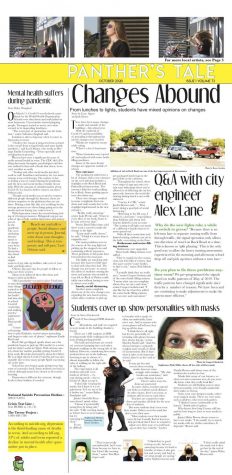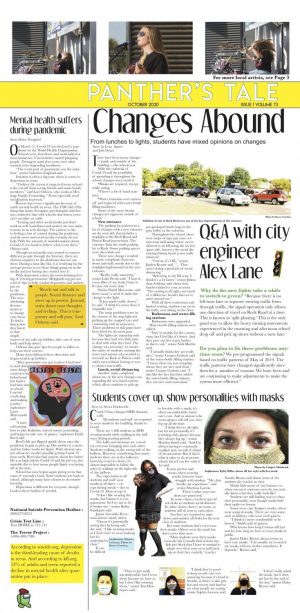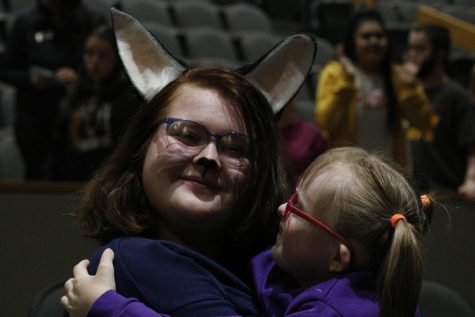Page 1: Mental health suffers during pandemic
October 8, 2020
On March 11, Covid-19 was declared a pandemic by the World Health Organization. Schools were shut down and work halted at most businesses. Uncertainties started plaguing people. Teenagers started to worry over what seemed to be impending loneliness.
“The worst part of quarantine was the isolation,” senior Valentine England said.
Isolation is often a big issue when it comes to depression in teens.
“I believe the reason it impacted teens so hard is the cut-off from seeing friends and some family members,” said Lori Osborn, who works at Heritage Family Counseling. “Teens especially need socialization in person.”
Doctors have seen a significant decrease of stable mental health in teens. In late June the CDC reported that 31% of adults(teens) began to experience symptoms of depression and anxiety. The thing that many therapists, psychologists and doctors realized is that with schools shut down, teens can’t socialize as easily.
“Texting and other social media just don’t work as well. Loneliness and anxiety are two main reasons teens seek therapy. The anxiety is due to feeling a loss of control during the pandemic, and the news and social media certainly do not help. With the amount of misinformation about Covid-19, it is hard to believe what is out there,” Osborn said.
Though social media was created to connect different people through the Internet, there are obvious negatives to the platforms that are out there. During a time like this, it is terrifying for the average person to see these things going on in the media and not having any control over it.
With depression comes the overwhelming feeling of it being permanent. Helpguide.org put out a list of tips to help combat depression and anxiety put on by the pandemic. The overwhelming denominator is to change your focus. To find a distraction they listed to find simple sources of joy, take up hobbies, take care of your body and help others.
Many teens followed these directions and began to pick up hobbies.
“After quarantine was put in place I had time to start doing some things I wanted to do beforehand but hadn’t had time due to school. I started crocheting and making jewelry,” sophomore Larry Marczynski said.
“I started learning how to play Kalimba, started nature journaling, and began to take care of plants,” sophomore Emily Reed said.
Reed’s life got flipped upside down once the pandemic began to pick up. Her mother is a nurse and her father works for Spirit. With obvious anxiety about her mother possibly getting Covid-19 from work, Reed also had anxiety about her father. He is at high risk for Covid-19 and his job was also unstable due to how many people Spirit was laying off at the time.
School has now begun again giving teens that sense of normalcy back. Some students are back in school, although many have chosen to do remote learning.
Depression is different for everyone, though. Look to these hotlines if needed.
National Suicide Prevention Hotline – (800)273-8255
Crisis Text Line – Text HOME to 741-741
The Trevor Project – 1-886-488-7386
According to Suicide.org depression is the third leading cause of deaths in teens, and according to kff.org 53% of adults (and teens) reported having their mental health decline after quarantine was put in place.
“Reach out and talk to people. Social distance and meet up in person. Journal, write down your thoughts and feelings. This is temporary and will pass,” Osborn said.


































